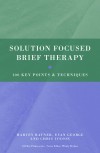 Ratner, George, and Iveson’s Solution Focused Brief Therapy: 100 Key Points Techniques, direct BRIEF, a coaching, therapy, training, and consulting center in London which currently happens to be the largest brief therapy training center in the world. The authors’ vast Solution Focused Brief Therapy (SFBT) experience is highlighted throughout the text.
Ratner, George, and Iveson’s Solution Focused Brief Therapy: 100 Key Points Techniques, direct BRIEF, a coaching, therapy, training, and consulting center in London which currently happens to be the largest brief therapy training center in the world. The authors’ vast Solution Focused Brief Therapy (SFBT) experience is highlighted throughout the text.
Supplied in an easy to read format, Solution Focused Brief Therapy: 100 Key Points & Techniques offers multiple relevant clinical case vignettes to guide the reader through the 100 points and techniques. The case examples are highly nuanced, further demonstrating the authors’ mastering of solution focused brief therapy and increasing the value and utility of the book. Solution focused practitioners search for instances of success in client’s lives, whereby creating new dialog outside of problem focused talk. In solution focused practice, common questions are those of difference: ‘What has worked in the past?’, ‘What difference are you hoping that will make?’, and ‘Who else would notice that coming here has been useful for you?’. Point 66 of 100 is a direct example; under the part on conducting follow-up sessions, subtitled, When the client says things are worse , the authors write: “There will be a time when every solution focused brief therapist asks [the client(s)], ‘so what has been better’ and the client will answer ‘you’re joking surely, it’s been worse, ten times worse. This week has been the worst week of my life’. While it can be tempting for the panicky counselor to try to trick the client out of his position [by responding] ‘but you got yourself here – how did you manage that?’. This statement from the practitioner contains the underlying logic of ‘if things were really so bad you wouldn’t be here, but you are here so it cannot be that bad’. The authors suggest this approach is always worth avoiding, because it does not validate the client’s difficulty before redirecting the conversation. This short clinical example is one of many housed within the 100 points in this text.
Solution Focused Brief Therapy: 100 Key Points & Techniques contains 16 parts which are further subdivided by the 100 key points and techniques. The authors begin Part I with the background of SFBT by discussing the Mental Research Institute in Milwaukee, social construction by Ken Gergen, Wittgenstein and his famous language games, and collaborative approaches to counseling. Part I ends with the assumptions of the client-counselor relationship, change processes, key assumptions, and an outline of first session goals. Part II describes compliments, taking turns in speech and acknowledging possibility. Part III, subtitled ‘Getting Started’ describes the beginning of therapy, techniques, and vital information to begin SFBT including a ‘resource audit.’
Part IV focuses on establishing a contract, or the joint project. The joint project function is finding the client’s best hopes from counseling, with guidelines for establishing a contract with involuntary clients and young clients. The authors describe the difference between outcome and process wherein the contract must contain a true ‘in-life’ difference versus working with a goal of ‘I just want to get things off my chest’. Part V describes broadening and detailing the client’s preferred future by the tomorrow question a derivative of the miracle question, and five key points to help the practitioner in defining and detailing preferred futures. Part VI describes exceptions, no exceptions and creating resource lists.
Part VII details the scaling techniques to measure progress, and practitioners helping clients to move up the scale. Part VIII outlines coping questions during difficult client stories and what to do during difficult sessions with issues such as bereavement. Part IX describes the role of the SFBT therapist during the termination process with Part X examining the follow-up sessions. Part XI is tailored to ending the work with clients, while XII is dedicated to assessment within SFBT. The next two sections are handling specific populations such as children, families, group work and adults. Part XV is dedicated to supervision, coaching, and organizational uses, with the last subtitle Part XVI answering frequently asked questions. This book is a worthy addition to any counselor’s bookshelf.
Ratner, H., George, E., & Iveson, C. (2012) . Solution focused brief therapy: 100 key points and techniques. New York, NY: Routledge.
Reviewed by: George E. Harrington III, doctoral counseling student, Barry University, Miami Shores, Florida.
The Professional Counselor Journal
